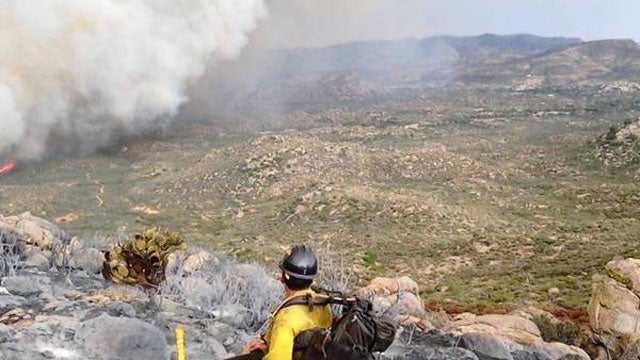On Saturday, September 23, the state of Arizona released the “Yarnell Hill Fire: Serious Accident Investigation Report,” a multi-agency investigation that looked into how, and why, 19 members of the Granite Mountain Hotshots were killed fighting a wildfire on June 30. The 116-page, in-depth document was, inevitably, not as comprehensive as the families, the public, and, no doubt, the investigators, would have liked. That’s because—as is summed up clearly on page one, and repeated often— “There’s a gap of over 30 minutes in the information available.” That half-hour begins shortly after the crew decided to leave “the black” (a safety zone of burned trees and brush), and ends in the moments before they died.
Video:
An overview of the Yarnell Hill Fire investigation.The authors address the lack of information head-on by separating the report into two sections. The first is the Factual and Management report and it’s written as a “fact-based narrative.” The second, titled “Discussion,” is intended to help readers interpret the tragedy. Here are the key points from the document:
The “Fact-Based Narrative”
The blow-by-blow description starts with the fire on the evening of June 28th and ends in the aftermath of the hotshots’ deaths. Though vague where the facts are thin, it sheds light on a few important points of confusion. The first is a conversation between Eric Marsh, the superintendent of Granite Mountain and the acting division supervisor for the southern section of the fire, and Brian Frisby, the superintendent of the Blue Ridge Hotshots, a second crew on scene. It took place shortly after the wind shifted at 3:50 p.m.
Marsh: “I want to pass on that we’re going to make our way to our escape route.”
Frisby: “You guys are in the black, correct?”
Marsh: “Yeah, we’re picking our way through the black.” He then mentions a road in the bottom of the valley and “going out toward the ranch,” a predetermined safety zone close to Yarnell.
Frisby: “DIVS A, to confirm, you’re talking about the road you saw me on with the UTV earlier, in the bottom.”
Marsh: “Yes, the road I saw you on with the Ranger [the UTV].”
Frisby believed the crew was heading northward, through their safety zone of blackened fuel. In fact they were moving south, toward Yarnell. That’s important because nobody on the fire, except the Granite Mountain Hotshots themselves, knew where the crew was headed. That confusion became a factor later when a VLAT—a DC-10 air tanker specially outfitted to drop retardant—flew overhead hoping to drop a load of slurry on the crew. They couldn’t find the hotshots. The rescue/recovery was delayed because searchers didn’t know Granite Mountain’s location.
Another key point clarified that the wind shifted not once, as has been widely reported, but twice. The first shift occurred around 3:50 p.m., blowing the fire to the southeast, back toward Yarnell. The second shift occurred around 4:30 p.m. and pushed the fire to the south. Though Granite Mountain was aware of the coming change in weather from reports broadcast over the radio, it’s possible the crew interpreted the first wind shift as the only wind shift, which helps explain why they committed themselves to a basin that became, effectively, a wind tunnel. One other revealing bit of information the investigation turned up was that the crew had only two minutes between the time the fire burned into the basin and when they deployed their shelters.
Analysis
The investigators address the critical, but information-thin 30 minutes before the Granite Mountain Hotshots were killed by laying out their increasingly limited options. The time period is broken down into three key decisions: 1) when the crew left the safety of the black; 2) when the crew decided to hike down into the basin where they were burned over, and 3) when the crew deployed their fire shelters.
Each decision point is set up with “What They Likely Knew,” and then followed with a few “Course of Actions”— the crew’s most logical options for reacting to the fire and the quickly changing situation. Though it’s made evident that this section of the report is speculative, it’s also the most definitive interpretation in the document of why and how the Granite Mountain Hotshots ended up in the basin where they were killed.
The report concludes, essentially, that the Granite Mountain team left the black, where they could do nothing to help the firefight, in order to reengage the fire. They committed to the basin because the Boulder Springs Ranch (in my recent story the ranch is ID’d as the Helm’s Place) was a “bombproof safety zone” that looked closer than it actually was. And they deployed where they did, rather than retreat back up hill or find a better, more-survivable deployment site, because they didn’t have time to do anything else.
Recommendations
The report also attempts to address how this fatality will affect future fire policy with seven bullet-pointed recommendations. Of the seven, two stand out.
The first is a suggestion that the State of Arizona should “review and possibly update its approach to mitigating wildfire threat to Arizona life and property.” What that means is that communities should be held responsible for creating defensible space—removing brush and timber—around houses and commercial structures, so that when fires do start near towns they extinguish on their own, before impacting property. It’s safer for firefighters to protect towns and houses with defensible space.
The second is a “review of current technology that could increase resource tracking, communications, real time weather, etc.” This suggests that firefighters carry transceivers, similar to those used in avalanche conditions, so their location can be tracked, and that crew supervisors should carry tablets or smartphones so they can follow weather in real-time and base decisions on hard data. Both suggestions make sense. They’re also very expensive and implementation, if it happens, will be years out at best.


